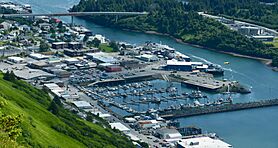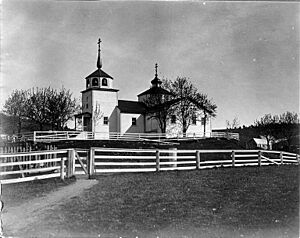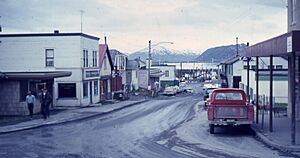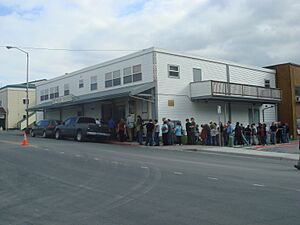Kodiak, Alaska facts for kids
Quick facts for kids
Kodiak
|
|||
|---|---|---|---|
| City of Kodiak | |||
|
View of Kodiak from Pillar Mountain
Downtown in 2021
Kodiak Harbor in 2014
The USCGC Spar at Coast Guard Base Kodiak
|
|||
|
|||
| Motto(s):
"Alaska's Emerald Isle"
|
|||
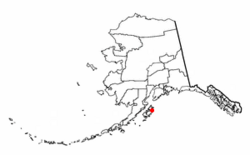
Location in Alaska
|
|||
| Country | United States | ||
| State | Alaska | ||
| Borough | Kodiak Island | ||
| Incorporated | September 11, 1940 | ||
| Area | |||
| • Total | 5.50 sq mi (14.23 km2) | ||
| • Land | 3.92 sq mi (10.16 km2) | ||
| • Water | 1.57 sq mi (4.07 km2) | ||
| Elevation | 49 ft (15 m) | ||
| Population
(2020)
|
|||
| • Total | 5,581 | ||
| • Density | 1,422.27/sq mi (549.11/km2) | ||
| Time zone | UTC-9 (AKST) | ||
| • Summer (DST) | UTC-8 (AKDT) | ||
| ZIP code |
99615, 99619, 99697
|
||
| Area code | 907 | ||
| FIPS code | 02-40950 | ||
| GNIS feature ID | 1404875 | ||
The City of Kodiak is the main city on Kodiak Island in Alaska. Its name in the Alutiiq language is Sun'aq. It is one of seven communities on the island. All travel to and from the island, whether by ferry or plane, goes through Kodiak.
In 2020, about 5,581 people lived in Kodiak. This makes it the tenth-largest city in Alaska.
The Alutiiq people have lived in Kodiak for over 7,000 years. In 1792, people from Russia settled here. They first called it Paul's Harbor. It was once the capital of Russian Alaska. Russian fur traders hunted many sea otters for their fur. This almost made the animal disappear.
Kodiak has faced two big natural disasters. In 1912, ash fell from the Novarupta volcano. In 1964, a huge tsunami hit the city after a large earthquake.
After the Alaska Purchase in 1867, the United States bought Alaska. Kodiak then became a major center for commercial fishing. Fishing is still very important to Kodiak's economy today. People also visit Kodiak for outdoor adventures. They come to hunt Salmon, halibut, the unique Kodiak bear, elk, Sitka deer, and mountain goats. The Alaska Department of Fish and Game helps hunters and fishermen get permits.
Kodiak has four public elementary schools, a middle school, and a high school. It also has a branch of the University of Alaska. People travel to and from the island by ferry on the Alaska Marine Highway and by local airlines.
Contents
History of Kodiak
Early People of Kodiak Island
Scientists believe the Kodiak Archipelago has been home to the Alutiiq people for at least 7,000 years. In their language, qikertaq means "island."
Russian Influence: 1700s to 1867
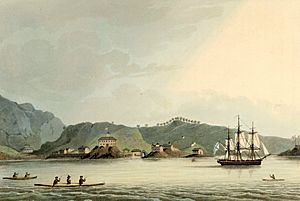
The first Europeans to see Kodiak Island were explorers Vitus Bering and Aleksei Chirikov in 1741. Later, in 1763, Russian fur trader Stepan Glotov sailed to Kodiak Island. The Russians called the island Kad’yak, which came from the Alutiiq word qikertaq. Other Russian fur traders visited in the 1770s. In 1778, British captain James Cook explored the area.
In 1792, Alexander Baranov, a leader of a Russian trading company, moved a trading post to a new spot called Paul's Harbor. This place grew into the modern city of Kodiak. The Russians built a warehouse there. It became important for trading valuable sea otter furs. This warehouse is now the Baranov Museum.
Christian missionaries from Russia also came to the island. They helped continue European settlement. The capital of Russian America later moved to Sitka in 1804. By the mid-1800s, the sea otter population was very low. Also, many native people were affected by European diseases.
American Control: 1867 to Today
In 1867, Russia sold Alaska to the United States. Kodiak then became a center for commercial fishing. Many fish canneries were built on the island in the early 1900s. Today, new fish processing centers keep the industry strong.
During the time of President Theodore Roosevelt, animals like the mountain goat, Sitka deer, rabbits, muskrats, beavers, and squirrels were brought to the island. The Kodiak National Wildlife Refuge was also created.
Kodiak was greatly affected by the 1912 eruption of Novarupta. The town was covered with about one foot of ash. People found shelter on a U.S. Revenue Cutter ship nearby.
Kodiak became an official city in 1941. During World War II, the U.S. worried about attacks from Japan. They built roads, an airport, and military forts on the island. When Alaska became a state in 1959, the government helped with housing, transportation, and education.
In March 1964, a huge tsunami hit Kodiak after the 1964 Alaska earthquake. The waves were about 30 feet high. Fifteen people died, and there was $11 million in damage. Some areas near Kodiak were lifted up by 30 feet. The tsunami also destroyed nearby native villages.
Geography and Climate
Kodiak is on the eastern shore of Kodiak Island. The city covers about 5.5 square miles. About 3.9 square miles are land, and 1.6 square miles are water.
Kodiak's Weather
Kodiak has a climate with cold winters and mild summers. It rains a lot throughout the year, but less in the summer.
| Climate data for Kodiak Airport, Alaska (1991–2020 normals, extremes 1913–present) | |||||||||||||
|---|---|---|---|---|---|---|---|---|---|---|---|---|---|
| Month | Jan | Feb | Mar | Apr | May | Jun | Jul | Aug | Sep | Oct | Nov | Dec | Year |
| Record high °F (°C) | 54 (12) |
60 (16) |
57 (14) |
70 (21) |
80 (27) |
86 (30) |
83 (28) |
86 (30) |
80 (27) |
74 (23) |
60 (16) |
65 (18) |
86 (30) |
| Mean maximum °F (°C) | 43.5 (6.4) |
43.9 (6.6) |
46.3 (7.9) |
53.8 (12.1) |
64.9 (18.3) |
71.1 (21.7) |
74.0 (23.3) |
73.5 (23.1) |
65.4 (18.6) |
56.0 (13.3) |
48.4 (9.1) |
44.5 (6.9) |
76.9 (24.9) |
| Mean daily maximum °F (°C) | 36.1 (2.3) |
37.5 (3.1) |
38.8 (3.8) |
44.7 (7.1) |
51.7 (10.9) |
57.0 (13.9) |
61.8 (16.6) |
62.8 (17.1) |
57.1 (13.9) |
48.3 (9.1) |
41.2 (5.1) |
37.3 (2.9) |
47.9 (8.8) |
| Daily mean °F (°C) | 31.2 (−0.4) |
32.4 (0.2) |
33.2 (0.7) |
39.1 (3.9) |
45.8 (7.7) |
51.4 (10.8) |
56.2 (13.4) |
56.5 (13.6) |
50.6 (10.3) |
42.2 (5.7) |
35.7 (2.1) |
31.9 (−0.1) |
42.2 (5.7) |
| Mean daily minimum °F (°C) | 26.2 (−3.2) |
27.2 (−2.7) |
27.6 (−2.4) |
33.6 (0.9) |
39.9 (4.4) |
45.7 (7.6) |
50.5 (10.3) |
50.3 (10.2) |
44.2 (6.8) |
36.0 (2.2) |
30.2 (−1.0) |
26.5 (−3.1) |
36.5 (2.5) |
| Mean minimum °F (°C) | 8.2 (−13.2) |
10.4 (−12.0) |
13.1 (−10.5) |
22.3 (−5.4) |
31.0 (−0.6) |
37.1 (2.8) |
43.1 (6.2) |
41.1 (5.1) |
32.1 (0.1) |
23.9 (−4.5) |
16.7 (−8.5) |
9.1 (−12.7) |
3.0 (−16.1) |
| Record low °F (°C) | −16 (−27) |
−12 (−24) |
−6 (−21) |
7 (−14) |
18 (−8) |
30 (−1) |
35 (2) |
34 (1) |
26 (−3) |
7 (−14) |
0 (−18) |
−9 (−23) |
−16 (−27) |
| Average precipitation inches (mm) | 8.35 (212) |
6.31 (160) |
4.82 (122) |
6.14 (156) |
5.85 (149) |
5.17 (131) |
4.51 (115) |
4.90 (124) |
7.55 (192) |
8.85 (225) |
7.06 (179) |
8.81 (224) |
78.32 (1,989) |
| Average snowfall inches (cm) | 14.5 (37) |
14.4 (37) |
12.3 (31) |
6.2 (16) |
0.5 (1.3) |
0.0 (0.0) |
0.0 (0.0) |
0.0 (0.0) |
0.0 (0.0) |
0.7 (1.8) |
6.1 (15) |
15.6 (40) |
70.3 (179) |
| Average precipitation days (≥ 0.01 in) | 18.8 | 17.3 | 15.9 | 18.0 | 16.5 | 16.1 | 14.6 | 14.8 | 17.0 | 18.4 | 17.0 | 19.7 | 204.1 |
| Average snowy days (≥ 0.1 in) | 8.9 | 7.6 | 9.2 | 4.0 | 0.5 | 0.0 | 0.0 | 0.0 | 0.0 | 1.1 | 5.1 | 9.1 | 45.5 |
| Average relative humidity (%) | 78.0 | 76.6 | 73.4 | 72.4 | 76.2 | 80.4 | 82.4 | 81.7 | 80.6 | 74.9 | 75.0 | 75.7 | 77.1 |
| Average dew point °F (°C) | 24.6 (−4.1) |
23.7 (−4.6) |
24.8 (−4.0) |
28.2 (−2.1) |
35.8 (2.1) |
43.2 (6.2) |
48.4 (9.1) |
48.6 (9.2) |
43.7 (6.5) |
32.4 (0.2) |
27.0 (−2.8) |
24.3 (−4.3) |
33.7 (0.9) |
| Source: NOAA (relative humidity and dew point 1961–1990) | |||||||||||||
People of Kodiak
| Historical population | |||
|---|---|---|---|
| Census | Pop. | %± | |
| 1880 | 288 | — | |
| 1890 | 495 | 71.9% | |
| 1900 | 341 | −31.1% | |
| 1910 | 438 | 28.4% | |
| 1920 | 374 | −14.6% | |
| 1930 | 442 | 18.2% | |
| 1940 | 864 | 95.5% | |
| 1950 | 1,710 | 97.9% | |
| 1960 | 2,628 | 53.7% | |
| 1970 | 3,798 | 44.5% | |
| 1980 | 4,756 | 25.2% | |
| 1990 | 6,365 | 33.8% | |
| 2000 | 6,334 | −0.5% | |
| 2010 | 6,130 | −3.2% | |
| 2020 | 5,581 | −9.0% | |
| source: | |||
Kodiak first appeared in the U.S. Census in 1880. It was called "Saint Paul" then. In 1890, it was called "Kadiak." By 1910, it was known as Kodiak. The city officially became incorporated in 1940.
In 2000, there were 6,334 people living in Kodiak. About 46.4% were White, 10.5% were Native American, and 31.7% were Asian. About 8.5% of the people were Hispanic or Latino. By 2020, the population had gone down to 5,581.
Many families live in Kodiak. In 2000, 40.2% of households had children under 18. The average household had 3.10 people. The average family had 3.64 people.
The average age of people in Kodiak was 34 years old. For every 100 females, there were about 114 males.
Kodiak is also home to a group of people called Russian Orthodox Old Believers.
Kodiak's Economy
Kodiak's economy is mainly based on fishing. The Alaska Department of Fish and Game helps manage fishing and hunting. They make sure people follow rules to protect the animals.
Military Presence
The United States Navy has a small training base near Kodiak. It's called Naval Special Warfare Cold Weather Detachment Kodiak. Here, United States Navy SEALs learn how to survive in cold weather. They also practice advanced tactics.
The United States Coast Guard has a large presence in Kodiak. They have:
- USCG Support Center Kodiak
- USCG Air Station Kodiak
- Ships like the USCGC Alex Haley and USCGC Cypress
- Teams that help with navigation and communication.
Fun Community Events
Kodiak hosts several yearly events. The most famous is the Kodiak Crab Festival. It happens during Memorial Day weekend. The festival is like a county fair with carnival rides, food, and games.
There are also many races during the festival:
- A kayak race
- A marathon (a long running race)
- An ultra-marathon (an even longer running race)
- A 9.2-mile mountain run called the Pillar Mountain Run
In 2019, they added a "Pardoning of the Crab" event. A crab is given a special name and saved from being eaten. It then lives at the Kodiak Fisheries Research Center Aquarium. For example, in 2021, a crab named Lenny Crabitz was pardoned.
Education in Kodiak
The Kodiak Island Borough School District runs schools in Kodiak. There are four elementary schools, one middle school, and one high school (Kodiak High School). There are also six schools in rural areas of the district.
Kodiak is home to Kodiak College. This is a part of the University of Alaska Anchorage.
Kodiak also has Saint Herman's Orthodox Theological Seminary. This school teaches students to become leaders in the Orthodox Church. Students come from villages all over Alaska to study here.
Media and News
Kodiak has several radio stations and a newspaper:
- KMXT (100.1 FM) is a community public radio station.
- KODK (90.7 FM) is another public radio station.
- KVOK-FM (101.1 FM) is a commercial radio station.
- KVOK (560 AM and 98.7 FM) plays country music and covers Kodiak Bears sports.
- Kodiak Daily Mirror is the local newspaper, published Monday through Friday.
Getting Around Kodiak
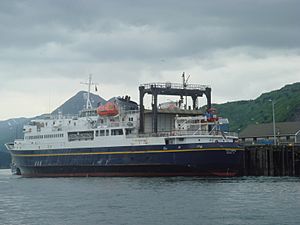
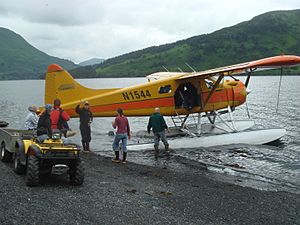
The Kodiak Airport is busy with local and regional airlines. Air taxis and charter floatplanes also fly from here. They help people travel on and off the island.
The Alaska Marine Highway offers ferry service. Two ferries, MV Tustumena and MV Kennicott, connect Kodiak to Homer and Whittier.
Floatplane and bush plane companies take tourists to remote areas. People go to wilderness lodges on the Kodiak Archipelago islands and the Katmai coast. They go for bear viewing, hunting, and hiking.
In the city, you can find taxis. You can also rent kayaks, mountain bikes, and all-terrain vehicles (ATVs).
Energy for Kodiak
Most of Kodiak's electricity comes from the Terror Lake Hydroelectric Generating Station. This station uses water power. Kodiak also gets a lot of energy from wind turbines. There are six wind turbines, each providing up to 1.5 megawatts of power.
Images for kids
See also
 In Spanish: Kodiak (Alaska) para niños
In Spanish: Kodiak (Alaska) para niños


